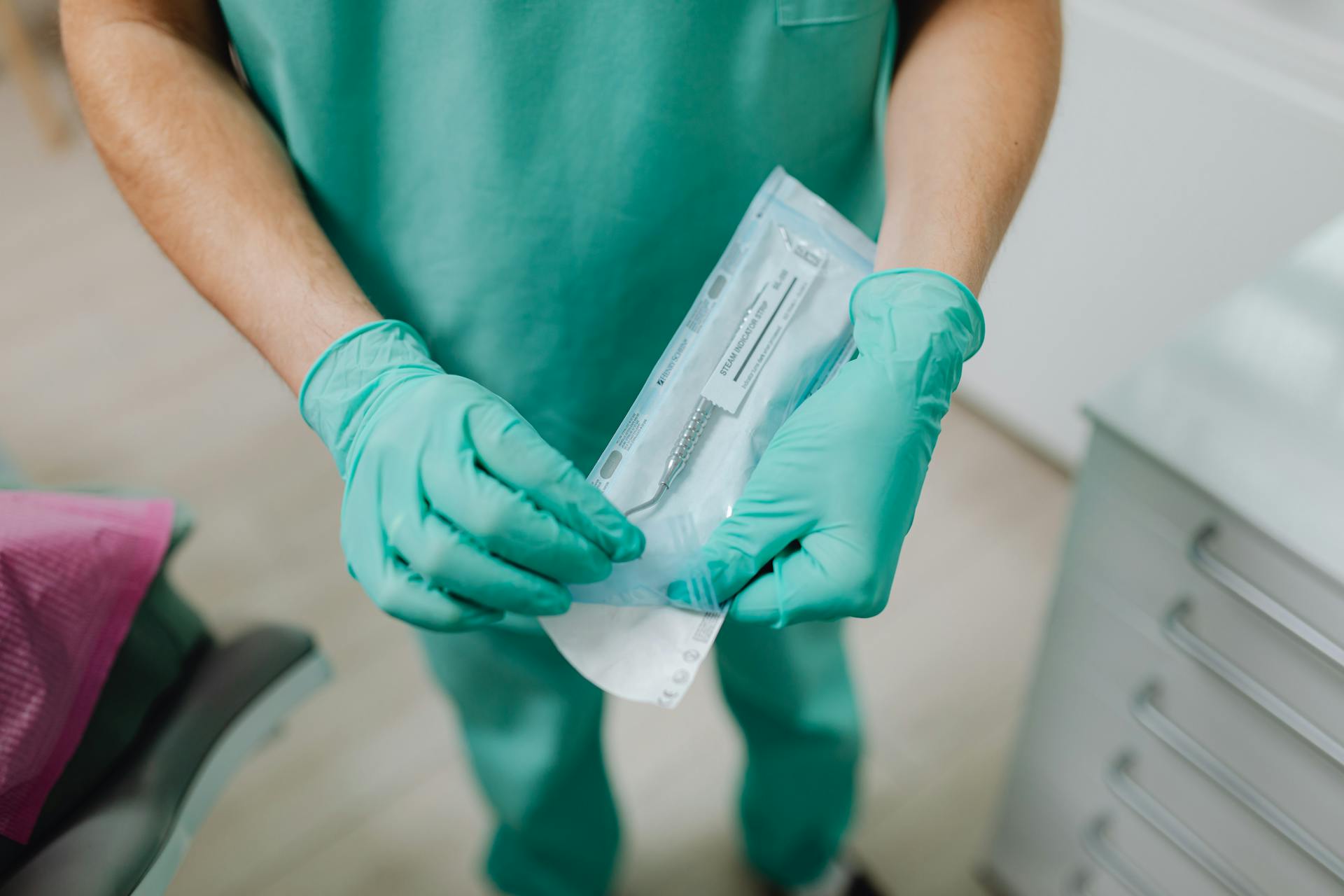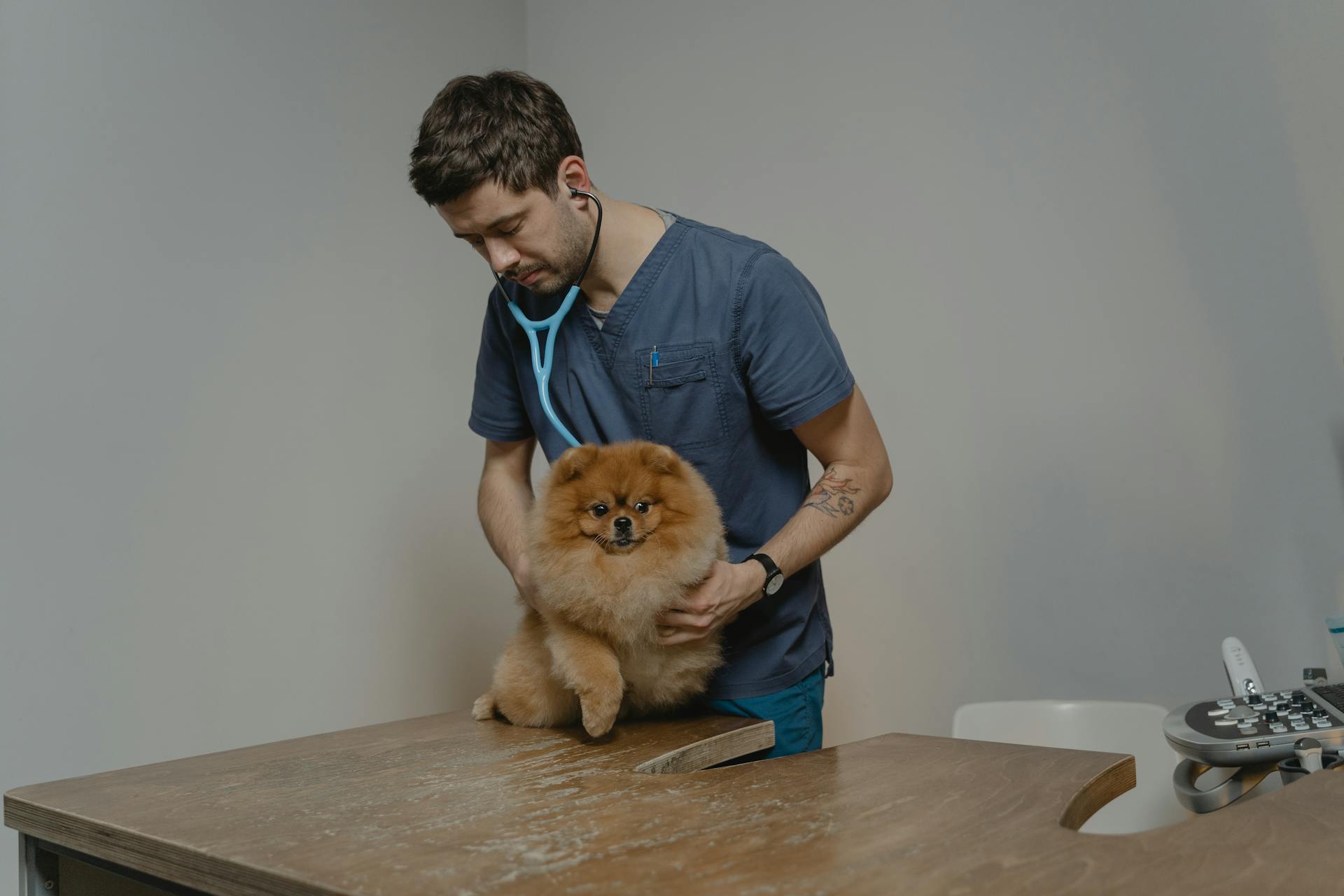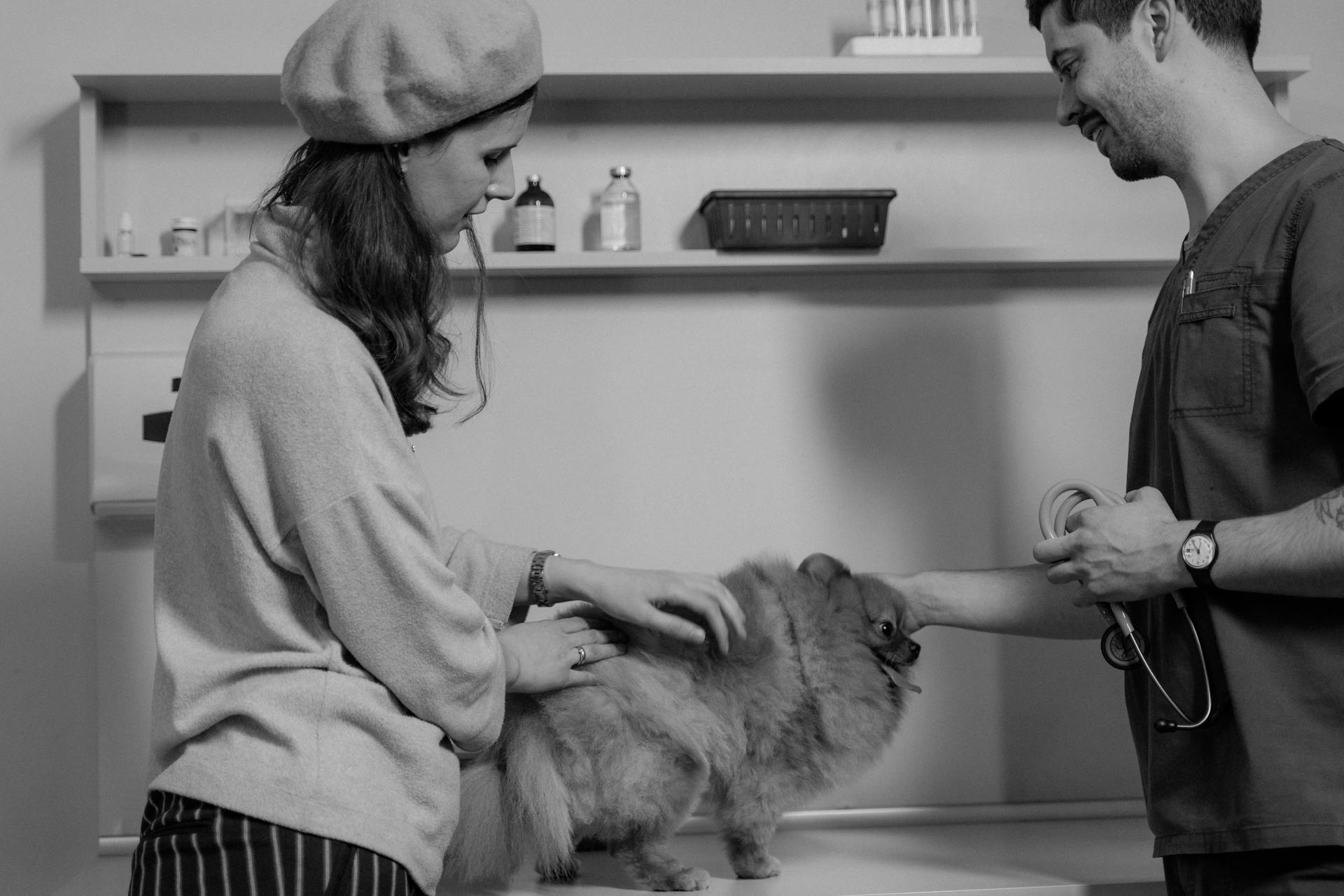
Sterilization is a common procedure for female dogs, and it's essential to understand the process and its benefits.
Spaying, or ovariohysterectomy, is a surgical procedure that removes the ovaries and uterus. This is the most common method of sterilization for female dogs.
Female dogs typically undergo spaying between 4 to 6 months of age, although some veterinarians may recommend spaying at an earlier or later age.
Spaying can help prevent unwanted litters and reduce the risk of certain health issues, such as uterine infections and breast tumors.
Take a look at this: At What Age Should a Female Dog Be Spayed
Why Neuter?
Neutering your female dog is a crucial decision that can have a significant impact on her health and well-being. By doing so, you can prevent unwanted pregnancies, which is a major concern for pet owners.
Here are some of the benefits of neutering your female dog:
- Prevents seasons
- Prevents pregnancy
- Prevents womb infections (pyometra)
- Prevents false pregnancies
- Reduces the chance of mammary/breast problems
By neutering your female dog, you can also reduce her risk of certain health issues, such as uterine, breast, and reproductive organ cancers, as well as uterine tract infections like pyrometra.
Benefits of Your Pet
Spaying or neutering your pet can have a significant impact on their overall health and well-being. Research shows that neutered male dogs have an 18% longer lifespan than those who are unneutered.
Spaying or neutering can also reduce the risk of certain cancers, including uterine, breast, testicular, prostate, and other reproductive organ cancers. This is a huge relief for pet owners who want to give their pets the best possible health outcomes.
In addition to health benefits, spaying or neutering can also curb undesirable behaviors such as urine marking, spraying, and dominance-related behaviors like aggression and fighting. These behaviors are often driven by the mating instinct, which can be eliminated with surgical sterilization.
By spaying or neutering your pet, you can also reduce their risk of being struck by a car, becoming involved in a serious fight with another animal, or being injured in other mishaps. This is especially true for females in the heat cycle, who are more likely to roam in search of a mate.
Take a look at this: Signs Female Dog Is Going into Heat
Here are some specific health benefits of spaying or neutering your pet:
- Reduction or elimination of risk for uterine, breast, testicular, prostate, and other reproductive organ cancers
- Prevention of uterine tract infections such as pyrometra, which can be fatal
- Lower incidence of benign prostatic hyperplasia (enlarged prostate gland), perianal tumors, and balanoposthitis (inflammation of the prepuce or canine foreskin)
By considering spaying or neutering your pet, you can give them a longer, healthier, and happier life.
Pet Benefits
Neutering your pet can have a significant impact on their health and well-being. Neutering a female dog can prevent womb infections (pyometra) and reduce the chance of mammary/breast problems.
The benefits of neutering extend beyond just health issues. It can also reduce undesirable behaviors such as roaming, which lowers the risk of being struck by a car or getting into fights with other animals.
In fact, research shows that neutered male dogs have an 18% longer lifespan than those who are unneutered. This is likely due to the reduction in risk for certain types of cancer.
Here are some of the key health benefits of neutering:
- Reduction or elimination of risk for uterine, breast, testicular, prostate, and other reproductive organ cancers
- Prevention of uterine tract infections such as pyrometra, which can be fatal
- Lower incidence of benign prostatic hyperplasia (enlarged prostate gland), perianal tumors, and balanoposthitis (inflammation of the prepuce or canine foreskin)
Overall, neutering can have a significant impact on your pet's health and happiness.
The Neutering Process
The neutering process for your female dog is a surgical procedure that involves removing her reproductive organs under general anesthesia. This will prevent her from reproducing and reduce or eliminate breeding-related behaviors.
The price of neutering your dog will depend on her size and your individual vet practice. You can call your vet for more information about prices, and if you're struggling to afford it, speak to your vet practice and local dog warden to find out if there's any charity help available.
Surgical sterilization for a pet will involve the removal of her reproductive organs under general anesthesia. The most common type of surgical sterilization procedure for female dogs is a complete ovariohysterectomy, which is the only technique we offer.
If this caught your attention, see: Female Dog Reproductive
The Operation
The operation itself is a relatively straightforward process. Your vet will check your dog over, give them a light sedative and some pain relief, and settle them in a warm, comfortable kennel.
Your dog will then be put under a full/general anaesthetic, which is a standard procedure for neutering.
They will be carefully monitored while their surgery site is clipped and cleaned ready for the procedure. This is an important step to ensure everything goes smoothly.
If your dog is female, your vet will make a small incision along the middle of her tummy so her ovaries and womb can be carefully removed. This is a common procedure for spaying.
If your dog is male, your vet will make a small incision just above the testicles so that both testicles can be carefully removed. This is a common procedure for castrating males.
In some cases, if your dog is cryptorchid, they may need two incisions for their castration.
Suggestion: Why Is My Female Dog Whining All of a Sudden
Surgical Types for Pets
Surgical sterilization for a pet involves removing their reproductive organs under general anesthesia. This process won't change their personality, playfulness, or ability to learn.
In fact, many pets display less unruly behavior after the procedure, making them more desirable companions. The most common types of surgical sterilization procedures for pets are:
- Orchiectomy (typical neuter): This procedure involves removing the testes in a male dog or cat, resulting in the inability to reproduce and reduction or elimination of breeding-related behaviors.
- Complete ovariohysterectomy: This is the only type of sterilization procedure we currently offer for female patients, which involves the removal of the ovaries and uterus.
Preparation and Care
Before scheduling your female dog's sterilization procedure, it's essential to consult with your veterinarian about the proper time to have the surgery, as it can be performed at any age but is usually recommended around 6 months.
Your vet will take into consideration your dog's breed, age, and physical condition when recommending the procedure. The old rule of waiting until the pet experiences her first heat cycle is not always the best option.
To ensure a hassle-free and safe operation, follow the veterinary hospital's instructions carefully. This includes not providing your dog with water or food the night before the surgery, as it might cause vomiting and aspiration during the procedure.
A carrier should be prepared for your dog after the surgery, as they will not be allowed to stress themselves with excessive movements. If it's the first time your dog will be using a carrier, some training could be given before the surgery to get them used to it.
Expand your knowledge: Why Does My Male Dog Lick My Female Dog's Pee
Here are some essential factors to take care of before the surgery:
- Do not feed your dog the night before surgery (after 6:00 PM. for large dogs and 8:00 PM. for smaller dogs).
- Prepare a carrier for your dog after the surgery.
A health examination will be performed prior to surgery to ensure that your pet is able to undergo anesthesia. Sterilization surgery typically lasts 30-60 minutes and your pet's vital signs will be closely monitored during the procedure and afterward in the intensive care unit.
A different take: How Long Is a Spay Surgery for Female Dog
Non-Surgical Injection
Non-surgical injection is a method of sterilization for pets where a chemical is injected into the testes to halt sperm production, resulting in infertility.
This procedure is still being researched and new methods are being developed to improve it.
Research continues to be conducted towards advancements in non-surgical sterilization.
It's a promising area of study that may one day provide a more convenient and less invasive option for pet sterilization.
Preparing for Your Pet's Surgery
It's essential to prepare your pet properly before surgery to ensure a smooth and safe operation. Your veterinarian will recommend the best time for spaying or neutering your pet, taking into account their breed, age, and physical condition.
You should consult your veterinarian about the proper time to have your pet spayed or neutered. They will consider your pet's breed, age, and physical condition when recommending any sterilization procedure.
Before the surgery, follow the veterinary hospital's instructions carefully. They may recommend not feeding your pet the night before surgery to prevent vomiting and aspiration.
A few days before the surgery, it's a good idea to introduce a carrier to your pet to help them get used to it. This will make it easier for them to travel to and from the veterinary hospital.
Here are some essential factors to take care of before the surgery:
- Don't feed your pet the night before surgery.
- Prepare a carrier for your pet to travel in.
- Follow the veterinary hospital's instructions carefully.
A pre-anesthetic blood profile can be performed within 3 months of surgery to test internal organ function and diagnose pre-existing medical conditions.
After Neutering
After neutering, your female dog will likely need a couple of check-ups with your vet to ensure they're healing properly. These check-ups usually take place 2-3 days and 7-10 days after the operation.
Your dog will need to be given time to recover from the anaesthetic, so keep an eye on them and follow your vet's advice. If you have any concerns before the check-up, don't hesitate to call your vet for guidance.
After being spayed, female dogs can experience some behavioural changes. They may become more relaxed and in control of their body and emotions. This is a significant change that can benefit both the pet owners and the dogs.
Female dogs that are prone to being on edge and nervous during their heat cycles will find relief after being spayed. They'll no longer experience heat and will be much more relaxed.
Once spayed, female dogs are less likely to roam away from the house in search of male dogs. This reduces the risk of them getting lost or into accidents. They may become more affectionate to their pet owners instead.
Aggressive behaviour in female dogs can be a problem, but being spayed can put a stop to it. This is often a result of the frustration and pain caused by their heat cycles.
After being spayed, female dogs may become extremely clingy and long for their pet owner's affection and attention. This is considered normal, as they no longer feel the need to roam away from the house in search of mates.
Intriguing read: Does Fixing a Female Dog Calm Them down
Risks and Complications
Neutering is a relatively safe procedure, but like any operation, there are risks and potential complications during and after surgery. Your vet will discuss the risks with you beforehand.
Complications can occur in dogs of all ages, but it's especially important to be aware of the potential for complications in senior dogs. Pet owners should be conscious of the post-operative complications that can take place in aged dogs.
Your vet will be able to discuss the risks and any concerns you may have, so don't hesitate to ask questions.
You might enjoy: Complications after Spaying a Female Dog
Complications
As you consider spaying or neutering your dog, it's natural to have some concerns about potential complications.
Your vet will discuss the risks with you beforehand, so don't hesitate to ask any questions if you have any concerns.
While complications can occur, they're relatively rare and can be minimized with proper care after surgery.
To ensure a smooth recovery, your vet will keep your dog under observation for hours after the surgery.

Pain medications will be prescribed to help your dog feel more comfortable during the recovery process.
To make your dog's recovery as comfortable as possible, make sure to provide plenty of pillows, blankets, and sheets for them to rest on.
In some cases, senior dogs may be at a higher risk for post-operative complications, so it's essential to discuss any concerns with your vet before the surgery.
Recommended read: Female Dog Spayed Recovery
Myth #1: Expensive Procedures
Spaying and neutering your dog may seem like an expensive procedure, but the cost can vary depending on the clinic you choose. The quality of service offered can also impact the price.
It's better to spend on sterilizing your dog than having to care for their litter and deal with behavioral and mental problems. This is especially true if you're adopting an adult dog from a shelter or pet home, as they may already be sterilized.
You might be eligible for a discount if you just rescued a dog and want to get it sterilized at a good clinic. Many hospitals offer this option, so be sure to ask!
Myth #2: Will Make You

Sterilizing your dog is a common practice, but many pet owners have misconceptions about it. One of these myths is that spaying or neutering will make your dog gain weight.
Only lack of exercise and no proper intake of food can contribute to gaining weight, not the sterilization surgery itself. Sterilizing will only help the dogs at both physical and mental levels.
A balanced diet and regular exercise are essential for maintaining a healthy weight, regardless of whether your dog is spayed or neutered.
Related reading: Sudden Weight Gain in Female Dog
Alternatives and Considerations
There are alternative sterilization options available, including ovariectomy, where the ovaries are removed and the uterus remains intact. This eliminates reproduction, heat cycle, and breeding instinct behaviors, similar to the traditional ovariohysterectomy.
Some breeds may be more prone to urinary incontinence after spaying, and certain breeds may be more at risk than others. Research has found that spayed females are two to three times more likely to develop urinary incontinence than entire bitches.
If you're considering having your dog spayed, it's essential to discuss the risks and benefits with your vet, as well as the age at which your dog will be spayed. Neutering your dog can change their metabolism, which may lead to weight gain if not managed properly.
A unique perspective: Female Dog Incontinence Treatment
Pet Financial Benefits
Spaying or neutering your pet can save you money in the long run. The cost of one unexpected litter can be expensive, including caring for the puppies or kittens and finding good homes for them.
Unaltered pets often display destructive behaviors in the home or fighting tendencies toward other animals, which can incur significant costs. These behaviors can be costly to address.
The cost of spaying and neutering will differ from clinic to clinic, depending on the quality of service offered. This cost can be a one-time expense, rather than ongoing costs associated with caring for an unaltered pet.
If you adopt an adult dog from an animal shelter or pet home, they may already be sterilized, saving you the cost of the procedure.
A unique perspective: How Much to Get Female Dog Fixed
Myths About Sterilization
Sterilization is a common practice for dog owners, but there are many misconceptions surrounding it. One myth is that the surgery is painful for dogs. However, dogs are under anesthesia during the procedure, so they don't feel a thing.
Some people believe that sterilization is a guarantee against certain health issues, but the truth is, it can actually increase the risk of others. For example, research has found links between neutering and joint problems in certain breeds, such as Golden Retrievers and Labrador Retrievers.
Another myth is that sterilization is a one-time decision, but the reality is that it can have ongoing effects on your dog's health. Neutering can change your dog's metabolism, making them more prone to weight gain if they're not fed the right food.
Urinary incontinence is another issue that can arise after sterilization, especially in female dogs. In fact, research has shown that spayed females are two to three times more likely to develop this condition than intact bitches.
It's worth noting that some breeds are more at risk for certain health issues after sterilization. For example, Dachshunds are prone to back issues, while Hungarian Vizslas may be at risk for certain cancers.
Here are some breeds that may be at risk for health issues after sterilization:
- Golden Retrievers: joint problems and certain cancers
- Labrador Retrievers: joint problems and certain cancers
- German Shepherd dogs: joint problems and certain cancers
- Hungarian Vizslas: certain cancers
- Dachshunds: back issues
It's essential to discuss the potential risks and benefits of sterilization with your veterinarian to make an informed decision for your dog. They can help you weigh the pros and cons and determine the best course of action for your furry friend.
Alternatives and Considerations

If you're considering alternative sterilization options for your pet, it's essential to know what's available. Surgical alternatives to traditional spaying and neutering exist and may be offered at specific facilities.
Knowing all the options will help you make an informed decision. Discussing them with your vet will ensure you arrive at the best decision for your family.
For female pets, one alternative to traditional spaying is ovariectomy. This procedure involves removing the ovaries, but leaving the uterus intact. Reproduction, heat cycle, and breeding instinct behaviors are all eliminated, similar to the traditional ovariohysterectomy.
Considerations to Think About
Spaying or neutering your dog is a significant decision that requires careful consideration. The procedure is irreversible, so it's essential to think about your dog's future and whether breeding is a possibility.
Some breeds are more prone to health issues after spaying or neutering, such as back problems in Dachshunds or joint issues in Golden Retrievers and Labrador Retrievers.
For more insights, see: Side Effects of Neutering a Female Dog

Urinary incontinence is a concern for some female dogs, especially those spayed at a young age. In fact, spayed females are two to three times more likely to develop urinary incontinence than intact bitches.
The texture and color of your dog's coat may change after spaying or neutering, which can be a consideration if you're planning to show your dog.
Here are some factors to consider when deciding whether to spay or neuter your dog:
The benefits of spaying or neutering, such as reducing undesirable behaviors and preventing certain health issues, are well-documented. However, it's essential to weigh these benefits against the potential risks and consider your dog's individual needs and circumstances.
Take a look at this: Dog Names Female Start with S
Difference Between Castration
Castration is a surgery that is performed only on male dogs to sterilize them.
Neutering and castration are often confused with each other, but they are distinct procedures.
The key difference between the two is that castration is specifically for male dogs, whereas neutering applies to both male and female dogs.
Castration can benefit pet dogs by reducing undesirable behaviors such as roaming and aggression.
In contrast to spaying, which is a surgery performed only on female dogs, castration is a unique procedure for males.
Frequently Asked Questions
How long does it take for a female dog to recover from sterilization?
Female dogs typically take 7-10 days to recover from sterilization, a slightly longer recovery time compared to males.
Is dog sterilization painful?
Dog sterilization discomfort is typically short-term, lasting a few days to a week. If your dog experiences prolonged pain, consult your vet for further guidance.
Sources
- https://www.pdsa.org.uk/pet-help-and-advice/pet-health-hub/other-veterinary-advice/dog-neutering-a-guide-to-castration-and-spaying
- https://www.plantationpethealthcenter.com/veterinary-surgery/spaying-neutering-pets/
- https://iadopt.in/dog-sterilization-everything-you-need-to-know/
- https://www.ahofstatesville.com/services/dogs/spay-neuter
- https://www.thekennelclub.org.uk/health-and-dog-care/health/health-and-care/a-z-of-health-and-care-issues/neutering-a-dog-castrating-and-spaying/
Featured Images: pexels.com


